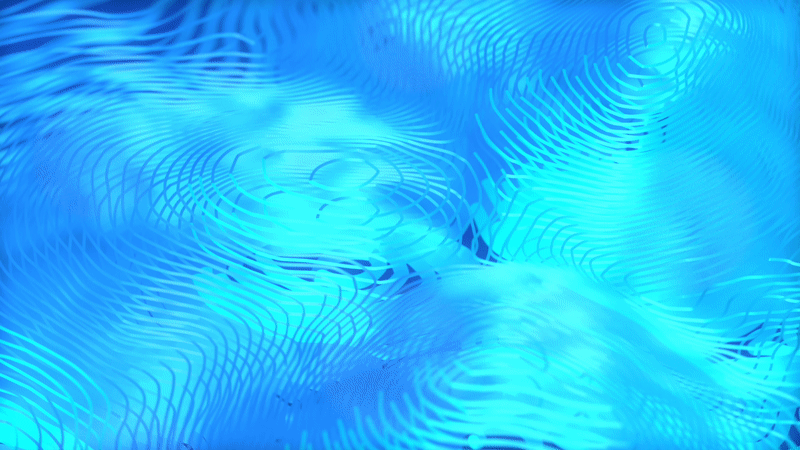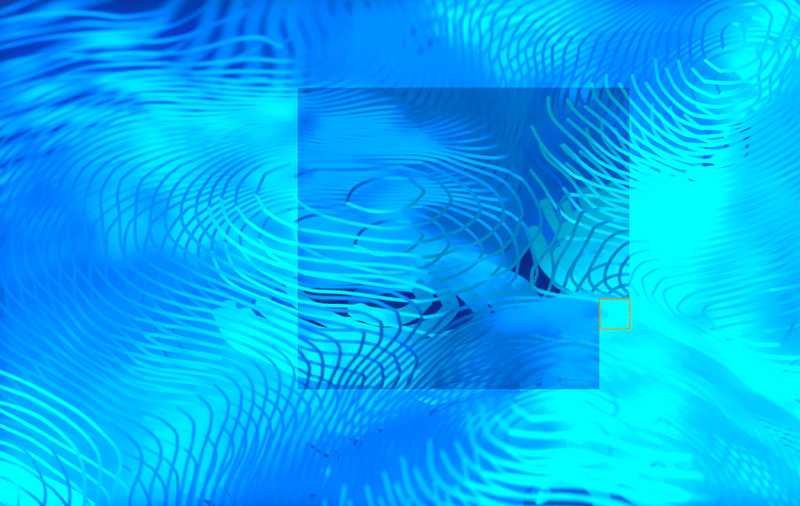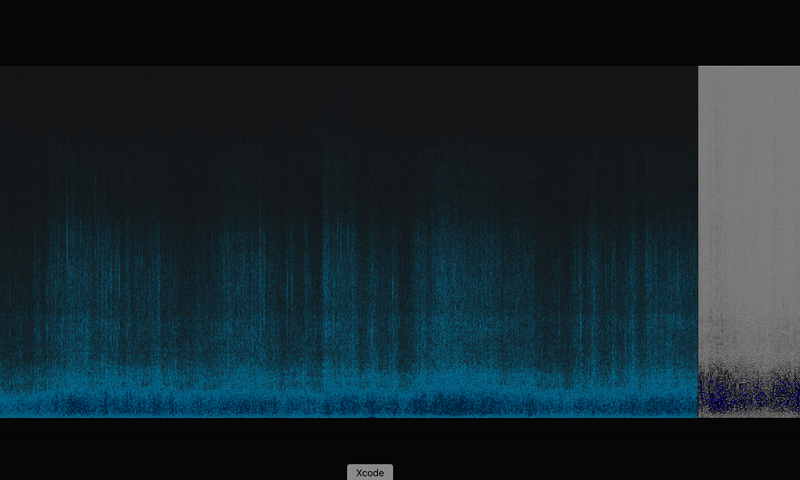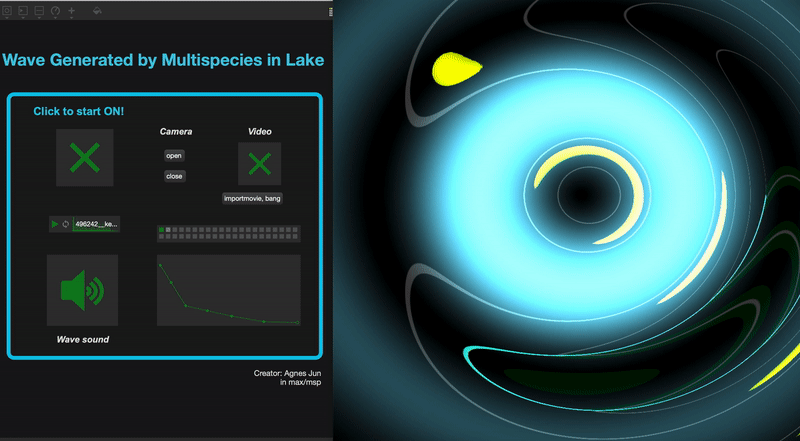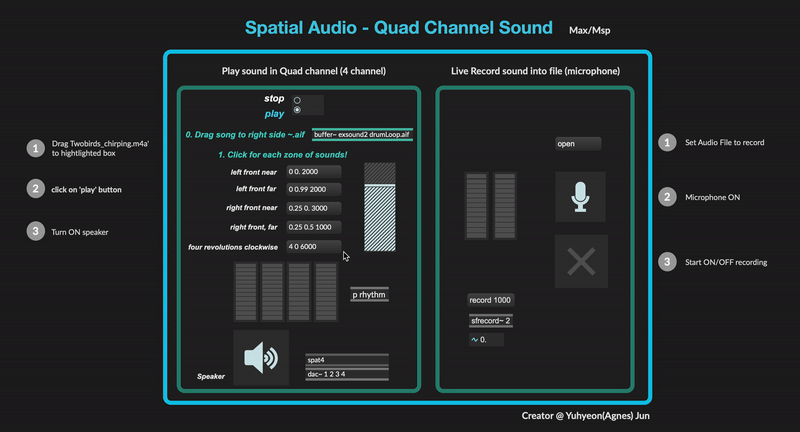Wave Scape in Lake
Producer: Yuhyeon(Agnes) Jun
It represents 'Acoustic harmony of multispecies' such as goose and ducks in Lake through 'how they live and communicate together by generative waves. Since we live in the world with rapid changes on both ecology and industrial processes, It is our challenge to interpret that how ‘species as seen or unseen’ itself in the perversity of nature, sonic ecology especially lake to be represented into harmonious and well-being experience for species to keep living well. With below artefact, since 'Binaural Spatial Sound' applied 'Best to enjoy with the speaker'.
Audiovisual 3D Artefact
Above My artefact highlights on “Vocalization of multi-species such as goose and ducks and biodiversity in Lake”. Particularly, with computational algorithm of sound panning and spectrogram, audience could be involved in immersive way of seeing and hearing the musical. It begins from collecting sounds and aspects by ‘Field recording’ in the lake.
Abstract and inspiration
I imagined collaborating with species living in the nature environments with archiving with field recordings in Lake. Since I was inspired by Bernie Krause and United Visual Artists’ narratives by biophonies. I began to explore on how to create musical with computational algorithm. Lakes in city such as in London are getting smaller and smaller, the species living there are getting difficulty with lack of care and protection. I wanted to shout out this aspect to keep protecting on species well living there together. Hence, I started to get sound and video recordings from lakes and observe the data showing how species in lake live together. Particularly, the wave forms / rippling / diffraction were part of aspects that I could get inspired of to generate musical of wave scape. Later on, I imagined ‘How do I attract audience to feel these aspects?’ the best things I could try was bring ecological sound and create into more spatial sound into whole musical performance.
Sound Experience with transformation on ecology
Since we live in places where rapid transformation of ecology and industrial development follows. By daily life experience and artistic observation on sound, we could feel how ‘ecological sound’ and ‘industrial noise’ are generated and brought to us. It could not only become noise but also harmonious music as well. In according to scientist, musician, and audiovisual artist, they tried to open new window on sound of nature and noise to be harmonious and tangible experience for audience in exhibition and musicals. I propose that how industry made sound ‘noise’ and ecological and nature ‘sound’ could cope together and reinterpreted for us to have well-being life in daily changing environment.
The Great Animal Vocalization as Orchestra
In audiovisual installation ‘The Great Animal Orchestra’(Bernie Krause and UVA, 2019), it particularly develops a passion for harmonious sounds of nature and animal. Since Bernie Krause had traveled the world in search of the non-human nature of music, he recorded diverse animal vocalizations. Considering deliberately the natural world as a poet and producing animal vocalization as a musician. In addition, the analysis of graphic representation is orchestrated as harmonious musical. It especially tells the story of impressive work on ‘heart of the sounds of nature’ with embrace on both aesthetic and technology. It shows how the earth becomes immense orchestra with a lively sonority and ensemble of millions of species all participating in gigantic musical concert. It gives us space to think on ‘the sounds and music of nature play an integral part of our daily life’.
Wave Scape as Musical Artefact
I've generated wave scape as Musical version as well to represent sensory exploration for the audience. I perform with nature species such as goose and ducks that I recorded in the field of the lake. Audiovisual effects are generated on my movements. The audience could experience “Vocalization of multi-species and biodiversity in Lake” collaborating with my live-performance generating wind sound and visualizing lively. The wave scape - musical video is below.
Field Recording Data
I had field - recorded sounds and archived them regularly from the Lake where multispecies such as ducks and goose live. It was to analyze by computational sound/visualizing algorithm and represent artefact based upon real sounds and data from the field.
Technical Implementation
Overally, it consists of whole 2 versions of techinical implementation with audio (spatial sound effect) and 3D generative visuals. Beginning from Storytelling artefacts from ‘Field recording’ method to analyzing computing programs such as ‘Max/Msp’ and ‘Cinema 4D’ to generate wave form and 3D spatial visual. With Spatial sound experience for audience, I approached and created wave pieces in Max/Msp’. Particularly, By applying two specialized technique such as ‘Multi-Channel Panning’ and ‘Spatialization’ in Max/Msp, I created patch to live record the spatial sounds coming out from my laptop. The recorded spatial sounds were used in wave spectrogram and 3D wave scape artefact, according to Giri M. ‘Electronic Music and Sound Design'. Lastly, I generated wave visual effects inspired by species such as goose and ducks rippling and living in the lake. The video below is for how I specially applied technical aspects 'Spatial / Multichannel' Sound experience.
Spatial Sound
I've implemented Quad-Channel sound effect with Field Recording sound of 'Duck in the Lake' by Max/Msp. The sound is below.
Annotated bibliography
1. Interview with Karen Barad “Matter feels, converses, suffers, desires, yearns and remembers”. Available at:https://quod.lib.umich.edu/o/ohp/11515701.0001.001/1:4.3/--new-materialism-interviews-cartographies?rgn=div2;view=fulltext
'Diffraction' is about heterogeneous history, not about originals. Also diffraction can be a metaphor for another kind of critical consciousness.” What can be labelled “new materialism” shifts these dualist structures by allowing for the conceptualization of the travelling of the fluxes of nature and culture, matter and mind, and opening up active theory formation. The entanglement of matter and meaning calls into question this set of dualisms that places nature on one side and culture on the other. Concerns into separate domains elides the resonances and dissonances that make up diffraction patterns that make the entanglements visible.
2. Krause, B. (2019). Interview with Bernie Krause by Michel Andre. ‘The Great Animal Orchestra’ The Musician of Nature by Gilles Boeuf. Paris : Fondation Cartier pour l’art contemporain
Every species that relies on sound for its survival tends to find a clear acoustic or temporal niche within which to assert its unique voice unimpeded by other. Being present in what remains of the wild natural environments simply make me feel more alive, alert, and concious of the wonders of life around me. All the rest-the science and the ability to create forms of art from the data, along with the contact with wonderful differently, nor, given the limited resources.
3. Brokewell council online ‘Lost rivers of London’. Available at: parks@lambeth.gov.uk
Water has always been and still a major feature within and around Brockwell Park. The Park in fact contains a tributary of the famous River Effra, one of the ‘lost rivers of London’. This lies on the western side of the park and drains surface water into ponds before running underground to join the main river at Brixton Water Lane. The three main ponds you see were deliberately created when this land was part of the Brockwell Estate, and have continued to exert a major influence on the way the park looks and operates. Interestingly the larger of the ponds used to be a boating pond, as well as an open air swimming pool in the park, with diving boards and changing rooms
Bibliography
1. Tsing, A. Arts of Living on a Damaged Planet: Ghosts and Monsters of the Anthropocene. Diffraction elaine gan. https://books.google.co.uk/booksid=pCl0DwAAQBAJ&pg=PT238&lpg=PT238&dq=diffraction+elaine+gan&source=bl&ots=vcp3iHow0L&sig=ACfU3U0_PSJVNB5A9xdPBEgT1RuszrTxyw&hl=en&sa=X&ved=2ahUKEwj62tWp_bXoAhX3aRUIHUQHA1QQ6AEwBXoECGQQAQ#v=onepage&q=diffraction%20elaine%20gan&f=false [Accessed 30/03/2020]
2. Barad, K. Diffracting Diffraction: Cutting Together-Apart. https://www.tandfonline.com/doi/abs/10.1080/13534645.2014.927623?queryID=%24%7BresultBean.queryID%7D [Accessed 30/03/2020]
3. Haraway, Donna. "Playing String Figures with Companion Species." Staying with the Trouble: Making Kin in the Cthulucene (2016): 9-29.
4. Haraway, Donna.SPECULATIVE FABULATION. https://www.youtube.com/watch?v=K1atjLfbNxE. [Accessed 05/03/2020]
5. Alessandro Cipriani, Electronic Music and Sound Design - Theory and Practice with Max 7 - Volumes 1.Introduction to Panning.
6. Krause, B. (2019) ‘The Great Animal Orchestra’ The Musician of Nature by Gilles Boeuf. Paris : Fondation Cartier pour l’art contemporain, pp.11-17
7. Maeder, M. (2015) Trees: Pinus sylvestris. https://jar-online.net/exposition/abstract/trees-pinus-sylvestris [Accessed 20/03/20].
8. Chattopadhyay, B. (2015) Talking Field: Listening to the Troubled Site. https://jar-online.net/exposition/abstract/talking-field-listening-troubled-site [Accessed 10/03/20].
9. Barbican. (2019) Ada Lovelace: Imagining the Analytical Engine https://www.barbican.org.uk/sites/default/files/documents/2019-10/ADA%20LOVELACE%20for%20web.pdf [Accessed 01/04/20]
10. Lennart, W. (2000) The origins of music. Primate Vocalization in Emotion and Thought. Massachusetts. The MIT Press.
































































